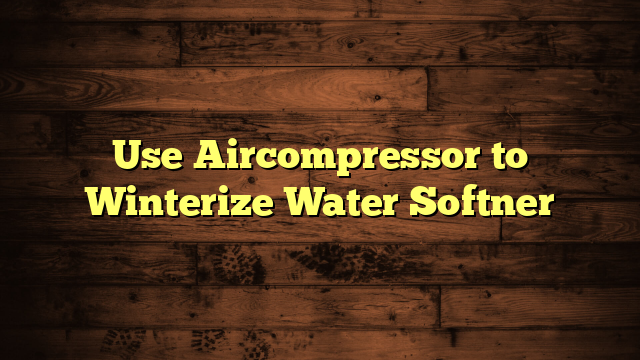Where Is Water Softner Installed?
You should install your water softener at your home's main entry point or near the main water line. This placement guarantees that all incoming water gets treated efficiently. You can also consider the laundry room for added convenience, especially if you want to boost your washing machine's performance. If space is tight, the basement or garage works too, just keep temperature considerations in mind. Make certain it's accessible for maintenance and away from clutter. Proper installation enhances effectiveness and reduces future issues. Stick around, and you'll find even more helpful tips on optimizing your water softening system.
Key Takeaways
- The ideal installation location is at the home entry point to treat all incoming water effectively.
- Installing in the laundry room enhances detergent efficiency and minimizes untreated water entering appliances.
- A basement location provides a controlled environment and easy access for maintenance.
- The garage offers extra space but requires consideration for temperature and electrical access.
- Positioning near the main water line reduces long-term issues and installation costs.
Understanding Water Softener Basics
When you think about improving your home's water quality, understanding the basics of a water softener is vital. One key concept is water hardness, which refers to the concentration of minerals, primarily calcium and magnesium, in your water supply. High water hardness can lead to various issues, such as scale buildup in pipes and appliances, reduced soap effectiveness, and dry skin.
The softening process involves removing these hard minerals through a method called ion exchange. In this process, the water softener replaces calcium and magnesium ions with sodium ions, effectively reducing water hardness. As water flows through the softener's resin tank, the hard minerals are trapped, and the softened water is sent to your home.
Maintaining your water softener is essential for peak performance. You'll need to periodically check the salt levels in the brine tank and replenish them as necessary.
If you notice any decline in water quality, such as increased soap scum or scale buildup, it might indicate that your softener isn't functioning properly.
Ideal Locations in the Home
When you're deciding where to install your water softener, consider the home entry point as a prime location.
This spot allows for easy access to the water supply and guarantees that all incoming water is treated.
Moreover, the laundry room is another great option, as it can help protect your appliances from hard water buildup.
Home Entry Point
Installing a water softener at the home entry point is vital for effective treatment of hard water. This location allows the system to treat all the water entering your home, guaranteeing that every faucet and appliance benefits from softened water.
When choosing the ideal spot, consider your home's layout and plumbing configuration, as well as your personal preferences. Homeowner preferences play a significant role in determining the best location. Some homeowners may prefer a discreet area, while others might want easy access for maintenance.
Entryway considerations, like proximity to main water lines and drainage, are also essential. You'll want to place the softener near the main water supply to minimize the amount of untreated water that enters your home.
Make certain the area has enough space for installation and future maintenance. Adequate ventilation and accessibility to power sources are also important factors.
Ultimately, selecting the right entry point not only enhances the performance of your water softener but also aligns with your lifestyle and home design. By keeping these factors in mind, you can guarantee your water softener installation meets your expectations and needs.
Laundry Room Placement
Choosing the laundry room as a location for your water softener can be highly beneficial. This placement optimizes your laundry room layout, ensuring that the water softener is close to appliances that require softened water, like your washing machine. By positioning it here, you can minimize plumbing complications and streamline water flow.
Here's a quick comparison of the benefits of installing a water softener in the laundry room versus other locations:
| Location | Advantages |
|---|---|
| Laundry Room | Close to washing machine; easy access for maintenance |
| Basement | Centralized for the home; can handle larger systems |
| Garage | Extra space; proximity to outdoor hoses |
| Kitchen | Convenient for dishwashers; may require more plumbing work |
When considering appliance proximity, the laundry room stands out. You'll save time and effort, as softened water enhances detergent efficiency and improves your laundry results. So, if you're looking for a practical and efficient setup, the laundry room is an ideal choice for your water softener installation.
Basement Installation Benefits
Often, homeowners find that installing a water softener in the basement offers significant advantages.
One major benefit is the controlled environment that basements typically provide. With lower basement humidity compared to other areas of your home, you can reduce the risk of damage to the water softener and guarantee peak functionality.
Additionally, basement accessibility makes maintenance and service easier. If you ever need to check or replace filters, having your water softener in the basement means you won't have to navigate through crowded spaces or disrupt the flow of daily life in your home.
Another advantage is that basements often have existing plumbing connections. This allows for a more straightforward installation process, saving you time and money.
Garage Installation Considerations
When considering where to install a water softener, the garage can be an excellent option for many homeowners. One of the first things you'll need to assess is your garage layout. Make sure there's enough space to accommodate the softener, along with any additional storage or plumbing needs. A clear area allows for better access during maintenance and repairs.
Next, think about electrical access. Most water softeners require power to operate, so you'll want to place it near an electrical outlet. If your garage lacks outlets, you may need to hire an electrician to install one, which could add to your installation costs.
Also, consider the temperature fluctuations in your garage. Extreme heat or cold can affect the softener's performance, so insulation or heating might be necessary depending on your climate.
Lastly, accessibility is key. You don't want to struggle to reach your water softener when it's time for upkeep. By addressing these considerations, you can make sure that your garage installation is practical and efficient, providing you with softened water for years to come.
Near the Main Water Line
When you're considering where to install your water softener, placing it near the main water line is ideal.
This location allows for better integration with your plumbing system and guarantees easy access for maintenance.
You'll find it much simpler to manage your water quality when everything's conveniently situated.
Ideal Installation Location
Choosing the ideal installation location for your water softener is essential for best performance, and placing it near the main water line is highly recommended. This setup guarantees that all the water entering your home gets treated, improving your water quality throughout. It also helps in reducing installation costs since it minimizes the need for extensive plumbing modifications.
Here's a quick overview of the benefits of installing your water softener near the main water line:
| Benefits | Description | Impact on Costs |
|---|---|---|
| Enhanced Water Quality | Treats all incoming water | Reduces long-term issues |
| Lower Installation Costs | Less plumbing work required | Saves on labor expenses |
| Increased Efficiency | Softens water before it enters the home | Improves system longevity |
| Simplified Maintenance | Easier access for routine checks and repairs | Lowers future maintenance costs |
Plumbing System Integration
Integrating your water softener into your plumbing system near the main water line guarantees seamless operation and ideal water treatment. This strategic placement allows your water softener to treat all incoming water, enhancing water quality throughout your home. When you connect the softener directly to the main line, you confirm that every tap, shower, and appliance benefits from softened water.
Proper plumbing integration is key to maximizing the efficiency of your water softener. By positioning it close to the main line, you minimize water waste and reduce the risk of pressure drops, which can affect your daily activities. Furthermore, this setup helps prevent potential damage to your plumbing from hard water buildup, which can lead to costly repairs down the line.
Moreover, integrating your water softener near the main water line simplifies the installation process. You'll have fewer complications, and it can often be completed in a single day.
It also allows for better monitoring of your water quality, as you can easily check the system's performance and make any necessary adjustments. Overall, this integration leads to a more efficient and effective softening process, confirming you enjoy better water quality consistently.
#
Accessibility for Maintenance
Positioning your water softener near the main water line not only optimizes water treatment but also enhances accessibility for maintenance.
When it comes to ensuring your system runs smoothly, maintenance accessibility is essential. Here are some benefits of having your water softener close to the main line:
- Easier Access: You can quickly reach the unit for any adjustments or repairs without maneuvering through obstacles.
- Routine Inspections: Having the softener nearby allows for more frequent and thorough inspections, ensuring everything is functioning properly.
- Reduced Downtime: If a problem arises, you'll be able to address it immediately, minimizing disruption to your water supply.
- Simplified Setup: Installation is typically easier and less costly when the softener is close to the main water line, reducing the need for extensive plumbing modifications.
## Accessibility for Maintenance
When installing a water softener, guaranteeing accessibility for maintenance is essential for its longevity and efficiency. You want to be able to reach the unit easily for regular inspections and any necessary servicing.
Consider the layout of your space, as cramped or cluttered areas can make maintenance a hassle. Placing the softener in a well-lit, open area will save you time and effort in the long run.
Make sure there's enough room around the unit for you to comfortably operate it and check components like the brine tank and control valve. If you ever need to replace parts or perform a deep clean, easy access can make a significant difference.
Also, think about the plumbing connections and drainage. Guarantee they're positioned in a way that doesn't obstruct your ability to work on the system. You might even want to label any valves or pipes to simplify the process during inspections.
Avoiding Common Mistakes
To guarantee your water softener operates effectively, it's vital to avoid common installation mistakes that can lead to costly issues down the line.
By following these location selection tips, you can make certain your system functions smoothly and efficiently.
- Ignoring Drainage Needs: Make sure the water softener is near a proper drain. Failing to do so can lead to water overflow and damage your home.
- Poor Ventilation: Don't install your softener in a cramped space. Good airflow is important to prevent overheating and promote peak performance.
- Neglecting Accessibility: Make certain your system is easily accessible for routine maintenance. If you can't reach it, you might skip important tasks like salt refills or cleaning.
- Choosing the Wrong Location: Avoid placing the softener in areas prone to extreme temperatures, like garages or attics. Fluctuating temps can affect the system's efficiency and lifespan.
Professional Installation Tips
While you might be tempted to tackle the installation yourself, hiring a professional can save you time and guarantee your water softener is set up correctly. Professionals bring expertise and can follow an installation checklist that confirms all critical steps are completed. Here are some professional recommendations to take into account:
| Step | Details |
|---|---|
| Site Assessment | Evaluate the best location for the unit. |
| Water Test | Conduct tests to determine hardness levels. |
| Proper Measurements | Verify accurate measurements to fit the softener. |
| Plumbing Preparation | Prepare existing plumbing to accommodate the new system. |
| Final Testing | Test the system for proper operation before completion. |
Frequently Asked Questions
Can I Install a Water Softener Myself?
Yes, you can install a water softener yourself! With the right tools and a bit of research on water softener types, DIY installation can be manageable and save you money. Just follow the instructions carefully!
How Much Space Is Needed for Installation?
For installation, you'll need at least 3 to 4 feet of space. Consider the installation requirements, including access to plumbing and drainage. Ascertain there's enough room for maintenance and possible future expansion of your system.
What Is the Average Cost of a Water Softener?
Imagine you're choosing between a salt-based and a salt-free water softener. The average installation costs range from $1,000 to $3,000, depending on the water softener types you select and any additional plumbing requirements.
How Often Do I Need to Maintain My Water Softener?
You should follow a regular maintenance schedule for your water softener, typically every few months. Regularly check for salt levels, clean the brine tank, and perform softener troubleshooting to guarantee peak performance and longevity.
Will a Water Softener Affect My Water Pressure?
A water softener can affect your water pressure, especially if it's not sized correctly. Proper installation guarantees softener efficiency, maintaining ideal pressure. Regular maintenance also helps prevent pressure drops caused by buildup or malfunctions.
Conclusion
Choosing the right spot for your water softener is like planting a tree in your garden; it needs the right soil and sunlight to thrive. By placing it near the main water line, you're ensuring it gets the nourishment it needs, while accessibility for maintenance keeps it healthy. Whether in the basement or garage, remember to avoid common pitfalls. With the right care and attention, your water softener will flourish, providing you with soft water for years to come.







